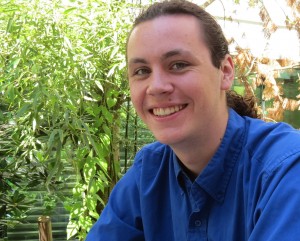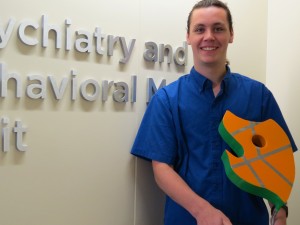 When I was 16, I spent 10 days at Seattle Children’s in the Inpatient Psychiatric Unit (now called the Psychiatry and Behavioral Medicine Unit, or PBMU).
When I was 16, I spent 10 days at Seattle Children’s in the Inpatient Psychiatric Unit (now called the Psychiatry and Behavioral Medicine Unit, or PBMU).
I fought it. I hated it. I couldn’t get out of there fast enough.
Looking back three years later, I can tell you that those were the most important 10 days of my life. If not for my time at Seattle Children’s, I’d probably be in jail now, or dead.
Everyone on the unit met my resistance with compassion – and somehow, they got through to me. Even though I fought being in their care, they cared for me. They cared about me.
I left Seattle Children’s with medications that helped me and coping skills I still use today.
How I found myself in the psych unit
No kid expects to end up in a psychiatric unit – I didn’t really know there was such a thing until the afternoon my parents took me to the emergency room at Seattle Children’s.
By then, I was failing every class at my high school, a super rigorous magnet school with a focus on STEM (science, technology, engineering and math).
I had squeaked by freshman year, but the academic pressure ratcheted up sophomore year. I spent eight unfocused hours with my homework every night, never finishing it well or on time. (Now I can see those hours for what they were: disorganized manic episodes). I was taking medication to treat attention deficit hyperactivity disorder (ADHD), but it didn’t seem to be working anymore.
To cope with the stress, I started using drugs. I didn’t know it, but I was using drugs to self-treat an undiagnosed mental illness.
I started bouncing between depression and mania. During my manic episodes, I stayed awake for days, unable to control my thoughts and barely able to control my actions. I pushed away my family and friends, kept my bedroom door closed and started doing a lot of erratic and irrational things.
One day in May, my parents were waiting for me when I got home from school. They took me to the emergency room at Seattle Children’s. I was admitted to the psychiatric unit that night.
How I found help…and art
As much as I tried not to, I got a lot of help at Seattle Children’s.
Every day I met with my care team to tell them I didn’t need to be there. For nine days they politely and thoughtfully disagreed.
I went through withdrawal from the drugs I’d been using and started taking medication to treat bipolar disorder and psychosis. It turns out that using illicit drugs was especially dangerous for me because of my underlying mental illness.
I learned about healthy coping skills, identified my triggers and worked on strategies to deal with them.
For the first time in a long time, my days had a predictable structure. I slept better than I had in months, and after a while I started feeling better.
During my downtime, I was surprised to learn that I liked drawing. I’m actually pretty good at it – I can’t draw faces or real things for the life of me, but I like to do abstracts.
When I first got home, art was the thing I appreciated most from my time at Seattle Children’s. If I ever got angry, I’d go up to my room and bust out a pen and paper and start drawing. Before long, I realized I was using the other coping skills I had learned on the unit.
Since I left the hospital, I’ve been going to a community-based program for people who have a dual diagnosis of mental disorder and drug problems. My team there is great, and we continue to build on what I learned at Seattle Children’s.
How I found a way to give back
I started my junior year at a new high school, and with a lot of hard work – and some very supportive teachers – I graduated on time in 2014. I have some good friends, and with a lot of time and effort I’ve earned back my parents’ trust.
I didn’t go to a four-year university like I thought I would, but instead I attend technical college where I’m learning welding, a trade that I love. I’m working part-time in a welding shop and saving money to get a place of my own.

As I started appreciating the unit that changed my life, I looked for ways to give back.
Two years ago, I donated games and art supplies to the unit; the next year, I donated iTunes gift cards for patients to buy apps.
When I asked Ann Moore, director of the PBMU, what I could donate this year, she asked if I would make a sculpture for the lobby. I was incredibly honored.
First, Ann took me on a tour of the PBMU, which has been completely transformed since my stay there. I was amazed – just blown away by the environment. The old unit felt like it was underground (even though it wasn’t), but you can’t feel that way in the new space. It has a lot more positive energy.
I tried to match that energy in my sculpture, which is made from metal. I gave it concave curves, which form sharp points when they meet; and also convex curves, which are softer and rounder. I think the shape mirrors our emotions – you have the anger of the sharp points and the peace and quiet of the curves.
I asked a guy I know who works at an auto body shop to paint it for me, and here’s where the story gets really cool. Instead of a bill, he sent the painted piece back to me with a $100 check made out to Seattle Children’s.
I still have my trigger card and inpatient wrist band from Seattle Children’s. They remind me of where I’ve been and where I might be today if I hadn’t gotten help when I needed it. I’m grateful to my parents for taking a desperate plunge and getting me to Seattle Children’s when I didn’t want to go, and to the staff there who looked past the angry teenager and helped me find the real John Madden again.

